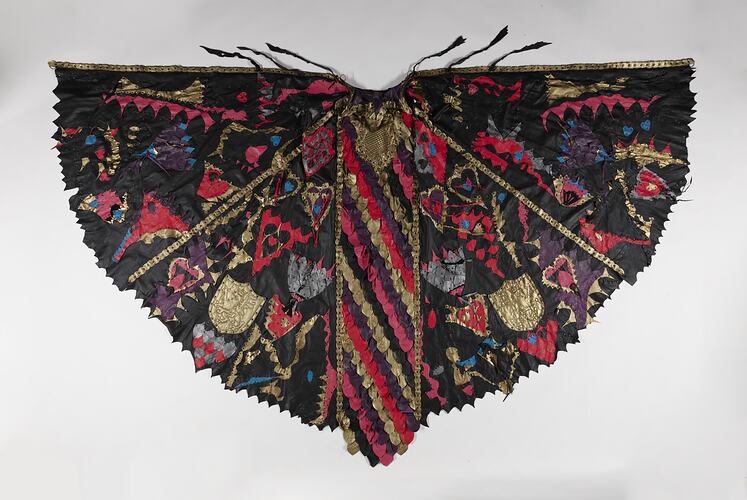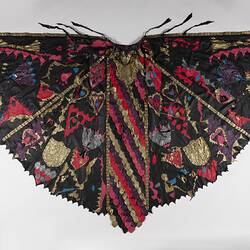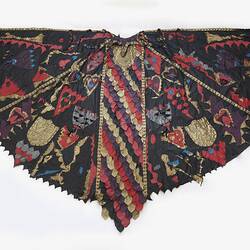Summary
Striking leather 'Queen of Hearts' cloak featuring brightly coloured leather hearts and overlapping scales designed and made in Melbourne by Jenny Bannister in 1982.
Measuring three metres wide, the cloak is made from scraps of leather in gold, purple, red, pink, and blue colours that have been cut into shapes and joined together with metal studs. The main visual motif is the heart shape which is used to decorate the cloak's four panels. Other motifs designed to invoke Medieval imagery and pageantry include the scotch thistle, a heraldic shield, and a crowned lion. The back of the cloak features a wide central panel made of pink, purple, gold, red, and black petal-shaped leather pieces joined together into an overlapping pattern to create a continuous line of scales that progress down the back and finishes at the hem.
Jenny made the cloak for the London Beauty Festival. Held at the newly opened Barbican Centre in May 1982, the show was staged over three days and featured a series of spectacular parades. It was considered at the time to be one of the world's largest international beauty shows which also included hairstyles by Vidal Sassoon.
Jenny was part of the first ever Australian contingent of creatives to be invited to show at the festival. The team was led by the South Yarra hairdresser Johny Morrey and included top Australian hairdressers Mara Schiavetti, Susan Barnes and Sandy New. The vivid make-up was created by Australian-born Richard Sharah who, at the time, was considered one of the world's top makeup artists having worked with Zandra Rhodes and David Bowie. The wardrobe was designed and made by Jenny Bannister, and the brightly dyed fantasy wigs made from yak and mohair were created by Edmond Reichmann.
Hairstyles and make-up were designed to match the look and feel of the outfits. Jenny Bannister recalls that the show received a standing ovation at the time.
It is part of the archives of Jenny Bannister, documenting her fashion design educational and vocational life, from the late 1960s until 2009.
Physical Description
Black leather cape made from scraps of coloured leather in gold, purple, red, pink, and blue cut into shapes and joined together with bronze metal studs. The heart shape motif decorates the cloak's four panels. Other motifs include a scotch thistle plant, a heraldic shield, and a crowned lion. The panels feature irregular pieces of leather either cut out to reveal a colour underneath or appliquéd in layers and joined together with metal studs. Several leather heart shapes in different colours have been cut out or appliquéd onto the black leather surface. Coloured pieces of leather have also been tied onto the cape and have been left to hang loose. On the lower end of two corresponding panels is a gold leather shield topstitched with the design of a crowned lion, a motif that is common in heraldry. The cape has a high purple leather collar with three points that have been stiffened with wire. The edge of the collar and the centre front openings are decorated with a narrow strip of leather made with small overlapping gold pieces joined together with metal studs to create a scaled effect. The back of the cape features a wide central panel made of pink, purple, gold, red, and black petal-shaped leather pieces sewn together into an overlapping pattern to create a a continuous line of scales that sequences down the back and finishes at the hem. The scales are bordered on either side by a narrow strip of leather made with smaller overlapping gold pieces joined together with metal studs in a scaled effect. The central panel ends in a point at the centre back. The upper part of the panel features a large offcut piece of gold leather top-stitched with the design of a globe surmounted with a crown together with the words 'Australian Land Corps.' The cape is fastened at the centre front with three leather ties on either side of the opening. On the inside of centre front facing is a row of brass metal hoops and Velcro dots. The edge of the hem is cut into small points. The cape is lined with black satin lining. Designer label is sewn to inside of cape at centre back neck.
Significance
The Jenny Bannister archive is of national significance, and is arguably the most important fashion design, manufacture and retailing archive still in existence. It documents the career of one of Australia's most significant designers and business women, who kept a thriving company going for almost 40 years, long after her contemporaries had retired or gone bankrupt.
No other collection documents this significant period in Australian fashion and clothing manufacturing so completely and succinctly; from the rise of an independent fashion industry in the 1960s and 70s, complimented by a strong local manufacturing sector, to the moving offshore of most of the manufacture as costs rosed to the eventual bankruptcy and closure of many local labels due to an increased overseas retail presence and rise of online consumerism.
Its importance was recognised by the National Library of Australia, who collected the bulk of her business and manufacture archival material, including 100 of patterns. It was only the second such collection to enter the institution, after that of prominent Sydney designer Linda Jackson.
She was the master of creativity and diversity, able to capture numerous markets, producing the most outlandish and artistic garments as well as highly commercial clothing. as renowned fashion historian and academic Professor Robyn Healy wrote 'Art Clothes, body sculpture, craft, theatrical costume, party clothes or serious fashion - Jenny Bannister's work transcends categorization. Like a New Age traveller, she explores the extraordinary, the primitive and the futuristic, to create garments for for kings, the Mardi Gras of the hip crowd'.
More Information
-
Collection Names
-
Collecting Areas
-
Designer
Jenny Bannister, Melbourne, Greater Melbourne, Victoria, Australia, 1982
-
Inscriptions
Black acetate label with machine embroidered gold text: 'Jenny Bannister'.
-
Classification
-
Category
-
Discipline
-
Type of item
-
Object Dimensions
2.2 m (Length), 3.3 m (Width)
2210mm (full length measured flat from top of collar) - 3315mm (full width measured flat)
-
Keywords
Australian Fashion Industry, Fashion, Fashion Design, Fashion Designers, Fashion Industry, Innovation & Design, Retailing, Clothing, Women's Clothing, Textiles


